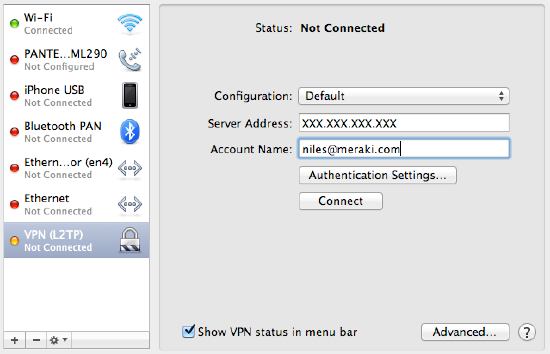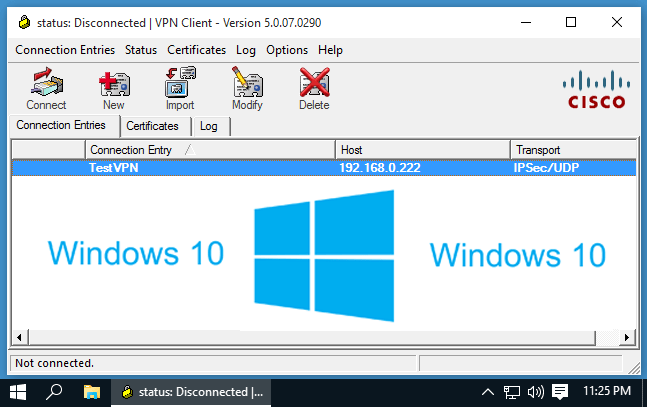Cisco ASA5500 – L2TP over IPSEC VPN https://www.petenetlive.com/KB/Article/0000571. Establish an IPSec Connection Between Cyberoam and Cisco VPN Client for Windows KB-000037738 Aug 29, 2018 0 people found this article helpful Applicable Version: 10.04.0 Build 214 onwards.
- Download Cisco Ipsec Vpn Client
- Cisco Vpn Support Windows 10
- Cisco Ipsec Vpn Client Windows 10
- Cisco Ipsec Vpn Client Windows 10 Alternative
- Cisco Client For Windows 10
- Cisco Ipsec Vpn Client Windows 10 Error 27850
Objective
IPSec VPN (Virtual Private Network) enables you to securely obtain remote resources by establishing an encrypted tunnel across the Internet.
The RV130 and RV130W work as IPSec VPN servers, and support the Shrew Soft VPN client.
Make sure to download the latest release of the client software.
• Shrew Soft (https://www.shrew.net/download/vpn)
Note: To be able to successfully setup and configure the Shrew Soft VPN client with an IPSec VPN server, you need to first configure the IPSec VPN server. For information about how to do this, refer to the article Configuration of an IPSec VPN Server on RV130 and RV130W.
The objective of this document is to show you how to use the Shrew Soft VPN client to connect with an IPSec VPN Server on the RV130 and RV130W.

Download Cisco Ipsec Vpn Client
Applicable Devices
• RV130W Wireless-N VPN Firewall
• RV130 VPN Firewall
System Requirements
• 32 or 64-bit systems
• Windows 2000, XP, Vista or Windows 7/8
Topology
A top level topology is shown below illustrating the devices involved in a Shrewsoft client to site configuration.
A more detailed flowchart illustrating the role of DNS servers in a small business network environment is shown below.
Software Version
• 1.0.1.3
Setup Shrew Soft VPN Client
IPSec VPN Setup and User Configuration
Step 1. Log in to the web configuration utility and choose VPN > IPSec VPN Server > Setup. The Setup page opens.
Step 2. Verify that the IPSec VPN Server for the RV130 is properly configured. If the IPSec VPN Server is not configured or misconfigured, refer to Configuration of an IPSec VPN Server on RV130 and RV130W and click Save.
Note: The above settings are an example of an RV130/RV130W IPSec VPN Server configuration. The settings are based on the document, Configuration of an IPSec VPN Server on RV130 and RV130W, and will be referred to in subsequent steps.
Step 3. Navigate to VPN > IPSec VPN Server > User. The User page appears.
Step 4. Click Add Row to add user accounts, used to authenticate the VPN clients (Extended Authentication), and enter the desired Username and Password in the fields provided.
Step 5. Click Save to save the settings.
VPN Client Configuration
Step 1. Open Shrew VPN Access Manager and click Add to add a profile.
The VPN Site Configuration window appears.
Step 2. In the Remote Host section under the General tab, enter the public Host Name or IP Address of the network you are trying to connect to.
Note: Ensure that the Port number is set to the default value of 500. For the VPN to work, the tunnel uses UDP port 500 which should be set to allow ISAKMP traffic to be forwarded at the firewall.
Cisco Vpn Support Windows 10
Step 3. In the Auto Configuration drop-down list, choose disabled.
The available options are defined as follows:
• Disabled — disables any automatic client configurations.
• IKE Config Pull — Allows setting requests from a computer by the client. With the support of the Pull method by the computer, the request returns a list of settings that are supported by the client.
• IKE Config Push — Gives a computer the opportunity to offer settings to the client through the configuration process. With the support of the Push method by the computer, the request returns a list of settings that are supported by the client.
• DHCP Over IPSec — Gives the client the opportunity to request settings from the computer through DHCP over IPSec.
Step 4. In the Local Host section, choose Use an existing adapter and current address in the Adapter Mode drop-down list.
The available options are defined as follows:
• Use a virtual adapter and assigned address — Allows the client to use a virtual adapter with a specified address as the source for its IPsec communications.
• Use a virtual adapter and random address — Allows the client to use a virtual adapter with a random address as the source for its IPsec communications.
• Use an existing adapter and current address — Allows the client to only use its existing, physical adapter with its current address as the source for its IPsec communications.
Step 5. Click on the Client tab. In the NAT Traversal drop-down list, select the same setting you configured on the RV130/RV130W for NAT Traversal in the article Configuration of an IPSec VPN Server on RV130 and RV130W.

The available Network Address Translation Traversal (NATT) menu options are defined as follows:
• Disable — The NATT protocol extensions will not be used.
• Enable — The NATT protocol extensions will only be used if the VPN Gateway indicates support during negotiations and NAT is detected.
• Force-Draft — The Draft version of the NATT protocol extensions will be used regardless of whether or not the VPN Gateway indicates support during negotiations or NAT is detected.
• Force-RFC — The RFC version of the NATT protocol will be used regardless of whether or not the VPN Gateway indicates support during negotiations or NAT is detected.
• Force-Cisco-UDP — Force UDP encapsulation for VPN clients without NAT.
Step 6. Click on the Name Resolution tab, and check the Enable DNS check box if you want to enable DNS. If specific DNS settings are not required for your site configuration, uncheck the Enable DNS check box.
Step 7. (Optional) If your remote gateway is configured to support the Configuration Exchange, the gateway is able to provide DNS settings automatically. If not, verify that the Obtain Automatically check box is unchecked and manually enter a valid DNS Server Address.
Step 8. (Optional) Click on the Name Resolution tab, check the Enable WINS check box if you want to enable the Windows Internet Name Server (WINS). If your remote gateway is configured to support the Configuration Exchange, the gateway is able to provide WINS settings automatically. If not, verify that the Obtain Automatically check box is unchecked and manually enter a valid WINS Server Address.
Note: By providing WINS configuration information, a client will be able to resolve WINS names using a server located in the remote private network. This is useful when attempting to access remote windows network resources using a Uniform Naming Convention path name. The WINS server would typically belong to a Windows Domain Controller or a Samba Server.
Step 9. Click on the Authentication tab, and select Mutual PSK + XAuth in the Authentication Method drop-down list.
The available options are defined as follows:
• Hybrid RSA + XAuth — The client credential is not needed. The client will authenticate the gateway. The credentials will be in the form of PEM or PKCS12 certificate files or key files type.
• Hybrid GRP + XAuth — The client credential is not needed. The client will authenticate the gateway. The credentials will be in the form of PEM or PKCS12 certificate file and a shared secret string.
• Mutual RSA + XAuth — Client and gateway both need credentials to authenticate. The credentials will be in the form of PEM or PKCS12 certificate files or key type.
• Mutual PSK + XAuth — Client and gateway both need credentials to authenticate. The credentials will be in the form of a shared secret string.
• Mutual RSA — Client and gateway both need credentials to authenticate. The credentials will be in the form of PEM or PKCS12 certificate files or key type.
• Mutual PSK — Client and gateway both need credentials to authenticate. The credentials will be in the form of a shared secret string.
Step 10. In the Authentication section, click on the Credentials sub-tab and enter the same pre-shared key you configured on the IPsec VPN Server Setup page in the Pre Shared Key field.
Step 11. Click on the Phase 1 tab. Configure the following parameters to have the same settings that you configured for the RV130/RV130W in Step 2 of the IPSec VPN Server User Configuration section of this document.
The parameters in Shrew Soft should match the RV130/RV130W configurations in Phase 1 as follows:
• “Exchange Type” should match “Exchange Mode”.
• “DH Exchange” should match “DH Group”.
• “Cipher Algorithm” should match “Encryption Algorithm”.
• “Hash Algorithm” should match “Authentication Algorithm”.
Step 12. (Optional) If your gateway offers a Cisco compatible vendor ID during phase1 negotiations, check the Enable Check Point Compatible Vendor ID check box. If the gateway does not, or you are unsure, leave the check box unchecked.
Step 13. Click on the Phase 2 tab. Configure the following parameters to have the same settings that you configured for the RV130/RV130W in Step 2 of the IPSec VPN Server User Configuration section of this document.
The parameters in Shrew Soft should match the RV130/RV130W configurations in Phase 2 as follows:
• “Transform Algorithm” should match “Encryption Algorithm”.
• “HMAC Algorithm” should match “Authentication Algorithm”.
• PFS Exchange” should match “DH Group” if PFS Key Group is enabled on the RV130/RV130W. Otherwise, select disabled.
• “Key Life Time limit” should match “IPSec SA Lifetime”.
Step 14. Click on the Policy tab and select require in the Policy Generation Level drop-down list. The Policy Generation Level option modifies the level in which IPsec Policies are generated. The different levels provided in the drop-down list map to IPSec SA negotiation behaviors implemented by different vendor implementations.
The available options are defined as follows:
• Auto — The client will automatically determine the appropriate IPSec Policy Level.
• Require — The client will not negotiate a unique Security Association (SA) for each policy. Policies are generated using the local public address as the local policy ID and the Remote Network Resources as the remote policy ID. The phase2 proposal will use the policy IDs during negotiation.
• Unique — The client will negotiate a unique SA for each policy.
• Shared – Policies are generated at the require level. The phase 2 proposal will use the local policy ID as the local ID and Any (0.0.0.0/0) as the remote ID during negotiation.
Step 15. Uncheck the Obtain Topology Automatically or Tunnel All check box. This option modifies the way security policies are configured for the connection. When disabled, Manual configuration must be performed. When enabled, Automatic configuration is performed.
Step 16. Click Add in order to add the Remote Network Resource you want to connect to. Remote network resources include remote desktop access, departmental resources, network drives, and secured electronic mail.
The Topology Entry window appears:
Step 17. In the Address field, enter the subnet ID of the RV130/RV130W. The address should match the IP Address field in Step 2 of the IPSec VPN Server Setup and User Configuration section of this document.
Step 18. In the Netmask field, enter the subnet mask for the RV130/RV130W’s local network. The netmask should match the Subnet Mask field in Step 2 of the IPSec VPN Server User Configuration section of this document.
Step 19. Click Ok to finish adding the Remote Network Resource.
Step 20. Click Save to save your configurations for connecting to the VPN Site.
Step 21. Return to the VPN Access Manager window to select the VPN Site you configured, and click the Connect button.
The VPN Connect window appears.
Step 22. In the Credentials section, enter the username and password of the account you set up in Step 4 of the IPSec VPN Server User Configuration section of this document.
Step 23. Click Connect to VPN into the RV130/RV130W.
The IPSec VPN tunnel is established and the VPN client can access the resource behind the RV130/RV130W LAN.
View a video related to this article...
Windows 8 and newer easily support IKEv2 VPNs, and Windows 7 can as well thoughthe processes are slightly different. The procedure in this section wasperformed on Windows 10, but Windows 8 is nearly identical. The procedure toimport certificates to Windows 7 can be found on the strongSwan Wiki
Import the CA to the Client PC¶
Export the CA Certificate from pfSense® and download or copy it to the clientPC:
Navigate to System > Cert Manager, Certificate Authorities tab onpfSense
Click by the CA to download only the certificate
Locate the downloaded file on the client PC (e.g. VPNCA.crt) as seen in FigureDownloaded CA Certificate
Double click the CA file
Click Install Certificate… as shown inCertificate Properties
Certificate Properties¶
Select Local Machine as shown inCertificate Import Wizard - Store Location
Click Next
Click Yes at the UAC prompt if it appears
Select Place all Certificates in the following store as shown in FigureCertificate Import Wizard - Browse for the Store
Certificate Import Wizard - Browse for the Store¶
Click Browse
Click Trusted Root Certification Authorities as shown in FigureSelect Certificate Store
Click Next
Review the details, they should match those in FigureCompleting the Certificate Import Wizard
Completing the Certificate Import Wizard¶
Click Finish
Click OK
Click OK
Setup the VPN Connection¶
Once the certificate has been properly imported it is time to create the clientVPN connection. The exact steps will vary depending on the version of Windowsbeing used by the client, but will be close to the following procedure.
Open Network and Sharing Center on the client PC
Click Set up a new connection or network
Select Connect to a workplace
Click Next
Select No, create a new connection
Click Next
Click Use my Internet Connection (VPN)
Enter the IP address or hostname of the server into the Internet addressfield as shown in FigureWindows IKEv2 VPN Connection Setup Screen
Note
This must match what is in the server certificate Common Name or a configured Subject Alternative Name!
Enter a Destination Name to identify the connection
Click Create
The connection has been added but with several undesirable defaults. For examplethe type defaults to automatic. A few settings need to be set by hand firstto ensure a proper connection is made. Refer to FigureWindows IKEv2 VPN Connection Properties
In Network Connections / Adapter Settings in Windows, find theconnection created above
Right click the connection
Click Properties
Click the Security tab
Set Type of VPN to IKEv2
Set Data Encryption to Require Encryption (disconnect if serverdeclines)
Set Authentication / Use Extensible Authentication Protocol to Microsoft:Secured password (EAP-MSCHAP v2) (encryption enabled)
Compare the values on the screen to those in FigureWindows IKEv2 VPN Connection Properties
Click OK

Windows IKEv2 VPN Connection Properties¶
Cisco Ipsec Vpn Client Windows 10
The connection is now ready to use.
Disable EKU Check¶
When the CA and server certificates are made properly on pfSense 2.2.4 andlater, this is not necessary. If an improperly generated server certificate mustbe used for some reason, then the Extended Key Usage check may need to bedisabled on Windows. Disabling this check also disables validation of thecertificate’s common name and SAN fields, so it is potentially dangerous. Anycertificate from the same CA could be used for the server when this is disabled,so proceed with caution.
To disable the extended key usage checks, open up Registry Editor on the Windowsclient and navigate to the following location in the client registry:
In there, add a new DWORD entry named DisableIKENameEkuCheck and set itto 1.
A reboot may be required to activate the setting.
Cisco Ipsec Vpn Client Windows 10 Alternative
Advanced Windows IPsec settings¶
With Windows 10 PowerShell cmdlet Set-NetIPsecMainModeCryptoSet it is possible tochange various advanced settings, like IPsec lifetime:
Cisco Client For Windows 10
This example modifies the maximum IPsec SA lifetime for the “pfSense IPsec” connection.The default Windows IPsec lifetime is 4800 minutes (eight hours).
See also
Cisco Ipsec Vpn Client Windows 10 Error 27850
For more information, see Windows 10 IPsec PowerShell cmdlets
